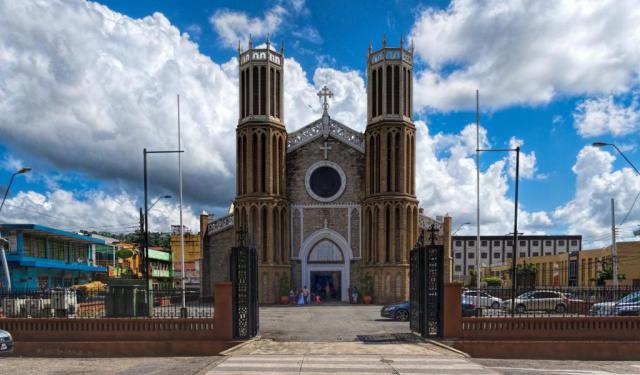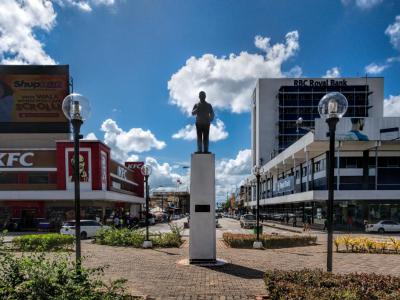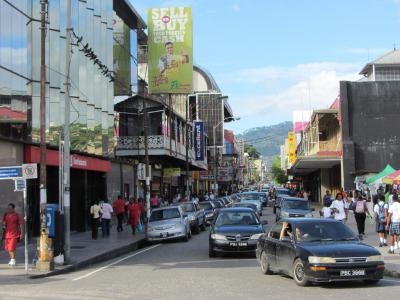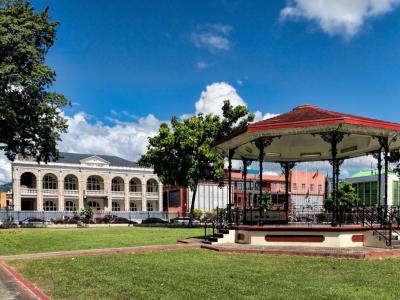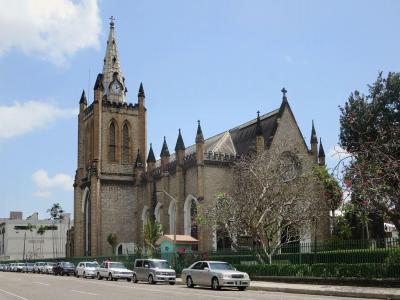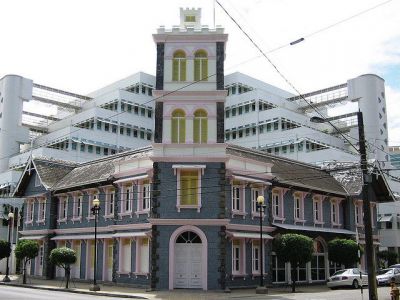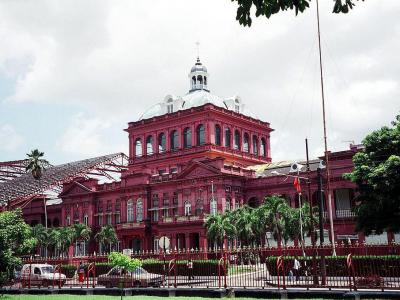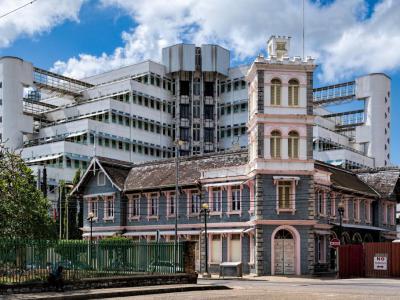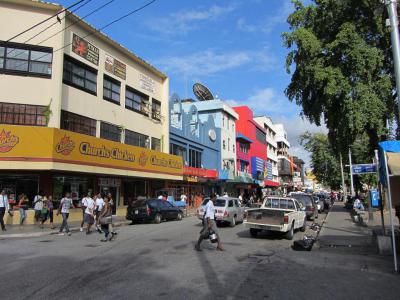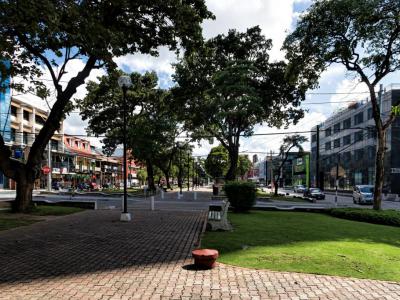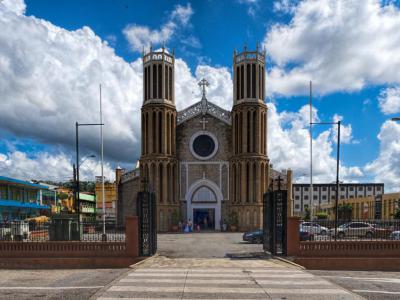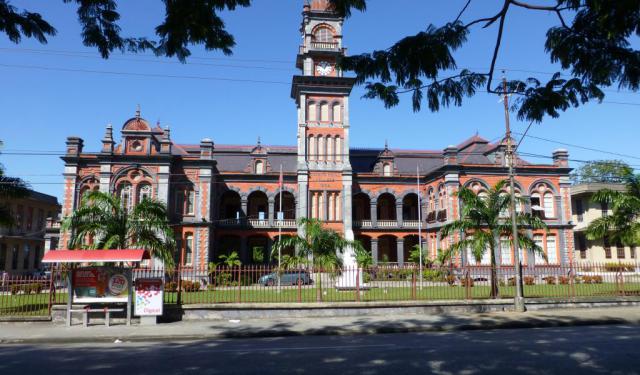Port of Spain Introduction Walk (Self Guided), Port of Spain
Port of Spain was once the site of a fishing village of Amerindian people. It was called "Place of the silk cotton trees." By 1560, a Spanish garrison was stationed in the area. By 1757, the village had changed to the capital of the Port of Spain.
The last Spanish governor of Trinidad, Don Jose Chacon, opened the colony to French Catholic immigrants. The population grew and the town expanded. Trinidad has been a destination of immigrants ever since. A grid system of eleven streets was laid out which survives in the downtown area today.
Along the shore, the Plaza de la Marina was established as a parade ground. In 1797, a British force under General Sir Ralph Abercromby landed near the town at a spot known today as Invaders Bay. After a brief diplomatic chat with Governor Chacon, the colony became British and the Plaza de la Marina became Marine Square.
Port of Spain today is a metropolis stretching along an east-west corridor under the foot of Trinidad's forested hills, the Northern Range. Downtown Port of Spain is the hub of business and commerce in the city. It is home to the Stock Exchange, the Central Bank, the city hall, called Red House, the courts, and various government ministries.
Two centuries of immigration show in the mixture of architectural styles. New Orleans style buildings mix with high-rises, Gothic Cathedrals, mosques and Hindu temples. There is a wide range of nightclubs and entertainment venues. Port of Spain hosts one of the biggest pre-Lenten blow out carnivals in the world.
For the hungry traveler there is a wild selection of Restaurants. Italian, Mexican, Thai, French, Chinese, Creole and Indian dining places vie for attention among the Jazz clubs and entertainment strips. Green spaces, squares and seaside promenades offer respite from all the hubbub.
Walk a while in the center of the city. See what it means to be "Trini 2 De Bone."
The last Spanish governor of Trinidad, Don Jose Chacon, opened the colony to French Catholic immigrants. The population grew and the town expanded. Trinidad has been a destination of immigrants ever since. A grid system of eleven streets was laid out which survives in the downtown area today.
Along the shore, the Plaza de la Marina was established as a parade ground. In 1797, a British force under General Sir Ralph Abercromby landed near the town at a spot known today as Invaders Bay. After a brief diplomatic chat with Governor Chacon, the colony became British and the Plaza de la Marina became Marine Square.
Port of Spain today is a metropolis stretching along an east-west corridor under the foot of Trinidad's forested hills, the Northern Range. Downtown Port of Spain is the hub of business and commerce in the city. It is home to the Stock Exchange, the Central Bank, the city hall, called Red House, the courts, and various government ministries.
Two centuries of immigration show in the mixture of architectural styles. New Orleans style buildings mix with high-rises, Gothic Cathedrals, mosques and Hindu temples. There is a wide range of nightclubs and entertainment venues. Port of Spain hosts one of the biggest pre-Lenten blow out carnivals in the world.
For the hungry traveler there is a wild selection of Restaurants. Italian, Mexican, Thai, French, Chinese, Creole and Indian dining places vie for attention among the Jazz clubs and entertainment strips. Green spaces, squares and seaside promenades offer respite from all the hubbub.
Walk a while in the center of the city. See what it means to be "Trini 2 De Bone."
How it works: Download the app "GPSmyCity: Walks in 1K+ Cities" from Apple App Store or Google Play Store to your mobile phone or tablet. The app turns your mobile device into a personal tour guide and its built-in GPS navigation functions guide you from one tour stop to next. The app works offline, so no data plan is needed when traveling abroad.
Port of Spain Introduction Walk Map
Guide Name: Port of Spain Introduction Walk
Guide Location: Trinidad and Tobago » Port of Spain (See other walking tours in Port of Spain)
Guide Type: Self-guided Walking Tour (Sightseeing)
# of Attractions: 10
Tour Duration: 1 Hour(s)
Travel Distance: 1.7 Km or 1.1 Miles
Author: sabrina
Sight(s) Featured in This Guide:
Guide Location: Trinidad and Tobago » Port of Spain (See other walking tours in Port of Spain)
Guide Type: Self-guided Walking Tour (Sightseeing)
# of Attractions: 10
Tour Duration: 1 Hour(s)
Travel Distance: 1.7 Km or 1.1 Miles
Author: sabrina
Sight(s) Featured in This Guide:
- Independence Square
- Frederick Street
- Woodford Square
- Holy Trinity Cathedral
- Old Fire Station
- Red House
- Old Public Library
- Henry Street
- Brian Lara Promenade
- Cathedral of the Immaculate Conception
1) Independence Square (must see)
At the time of the first European contact, the Awawakan-speaking indigenous people had set up the fishing village Cumucurapo, which means 'the place of Silk Cotton Trees'; on the western shore of Trinidad, then called "Kairi" (Land of the Hummingbirds). The Spanish established Puerto de Espana (Port of Spain) in 1560. The boat landing place of the old village became Plaza del Marina (Marine Square).
In 1797 the British arrived, led by General Sir Ralph Abercromby. They landed immediately west of Port of Spain at a place still known as "Invaders Bay." The British went about changing place names, and Plaza del Marina became simply "Marine Square." The Square was officially renamed "Independence Square" in 1962.
The Square today is an east-to-west elongated rectangle. Partially constructed on reclaimed land, it is bound to the east by the Cathedral of the Immaculate Conception. The western end is the Brian Lara Waterfront Promenade. The north side street is North Independence Square. The southern border road is, naturally, South Independence Square.
Skyscrapers like the Nicholas Tower and Eric Williams Plaza, named after Eric Williams, the first Prime Minister of Trinidad and Tabaco, are at the western end. Along its length, it is a tree-lined parkway. Fast food places like KFC abound. There is speedy traffic on both sides of the Square. In the middle of the Square is a fountain and a statue of Captain Arthur Andrew Cipriani, politician and sportsman of Trinidad.
In 1797 the British arrived, led by General Sir Ralph Abercromby. They landed immediately west of Port of Spain at a place still known as "Invaders Bay." The British went about changing place names, and Plaza del Marina became simply "Marine Square." The Square was officially renamed "Independence Square" in 1962.
The Square today is an east-to-west elongated rectangle. Partially constructed on reclaimed land, it is bound to the east by the Cathedral of the Immaculate Conception. The western end is the Brian Lara Waterfront Promenade. The north side street is North Independence Square. The southern border road is, naturally, South Independence Square.
Skyscrapers like the Nicholas Tower and Eric Williams Plaza, named after Eric Williams, the first Prime Minister of Trinidad and Tabaco, are at the western end. Along its length, it is a tree-lined parkway. Fast food places like KFC abound. There is speedy traffic on both sides of the Square. In the middle of the Square is a fountain and a statue of Captain Arthur Andrew Cipriani, politician and sportsman of Trinidad.
2) Frederick Street
Frederick Street became the heart of town after the devastating fire of 1895, when it was rebuilt by the well-known Scottish architect George Brown. Today, Frederick Street is the discount shopping center of Port of Spain. There is car traffic, but it looks like most people walk. They make the rounds of the many stores holding bags and totes. Streets are shaded by awnings. Verandas give protection against both sun and rain. Second-floor galleries with ornate iron railings are a common sight.
Lines form in the morning outside stores like Courts, Standards, Payless, and others. The street has a lack of pawn shops and jewelry stores. The UA Investment Store on Frederick Street is filled with shoppers. Clothes, shoes, and appliances are the main items of interest.
Popular stores and malls on Frederick Street include: Excellent Stores; Colsort Mall; Capital Plaza, home to over 100 stores; Shoeland, on the corner of Prince Street; Keith Kahn's Books; Tulip Productions has carnival supplies; Miguel Moses is on the corner of Hart Street.
Lines form in the morning outside stores like Courts, Standards, Payless, and others. The street has a lack of pawn shops and jewelry stores. The UA Investment Store on Frederick Street is filled with shoppers. Clothes, shoes, and appliances are the main items of interest.
Popular stores and malls on Frederick Street include: Excellent Stores; Colsort Mall; Capital Plaza, home to over 100 stores; Shoeland, on the corner of Prince Street; Keith Kahn's Books; Tulip Productions has carnival supplies; Miguel Moses is on the corner of Hart Street.
3) Woodford Square
Woodford Square, Port of Spain, is not just another green space. It is on the Heritage Asset Inventory of Trinidad and Tobago. It tells the history of Port of Spain in all its stages, light and dark. It is bounded in the north by Knox Street, to the west by Abercromby Street, to the east by Frederick Street, and the south by Hart Street.
The area has been used as a burial site for the First Peoples and as a flogging and hanging place for slaves under British rule. It became the site of the Holy Trinity Anglican Church. In 1817, it was finally designed as a park by Governor Sir Ralph Woodford, a British colonial administrator who was the longest-serving governor of Trinidad. Woodford Square is the only Cabinet-approved Heritage District in the country.
It has been the arena for social and political activism concerning the issues of racism, inequality, labor, and taxes. The Water Riots of 1903, the People's National Movement of Doctor Eric Williams, the Labor struggles of the 1920s, the Black Power Movement, and the martyrdom of Basil Davis are all part of the story.
The Square has unique architectural aspects. The fountain in the center was donated in 1892. It shows a water goddess supported by mermen over a wide basin. Decorative features include the lily flower of French heraldry. Walking paths are laid out in the pattern of the Union Jack. The bandstand was installed in 1917.
The area has been used as a burial site for the First Peoples and as a flogging and hanging place for slaves under British rule. It became the site of the Holy Trinity Anglican Church. In 1817, it was finally designed as a park by Governor Sir Ralph Woodford, a British colonial administrator who was the longest-serving governor of Trinidad. Woodford Square is the only Cabinet-approved Heritage District in the country.
It has been the arena for social and political activism concerning the issues of racism, inequality, labor, and taxes. The Water Riots of 1903, the People's National Movement of Doctor Eric Williams, the Labor struggles of the 1920s, the Black Power Movement, and the martyrdom of Basil Davis are all part of the story.
The Square has unique architectural aspects. The fountain in the center was donated in 1892. It shows a water goddess supported by mermen over a wide basin. Decorative features include the lily flower of French heraldry. Walking paths are laid out in the pattern of the Union Jack. The bandstand was installed in 1917.
4) Holy Trinity Cathedral (must see)
At the time of the British takeover in 1797, the Christian population of Trinidad and Tobago was mostly Roman Catholic. Something had to be done! Anglican priests received royal appointments to establish the Anglican Church in the islands. Until the cathedral opened, the Spanish-built Moorish-style town council building harbored the congregation.
The present Cathedral stands on the site of a much earlier church that burned in the Great Fire of 1808. The new church was consecrated in May 1823. The style of the Cathedral mixes Gothic Revival with elements of the Victorian age. It was designed by British architect and colonial secretary Phillip Reinagle.
The Cathedral design stresses the idea of altitude. The structure features buttresses with pinnacles. An overly tall bell tower and steeply angled pitched roofs are over the nave and chancel. The Gothic Revival finds further expression in the lancet stained-glass windows and pointed arch double doors.
Construction materials included blue limestone from the Laventille Hills, lime mortar and yellow brick transported from the Hollington quarries in England. The roof is supported by hammer beams of carved mahogany. The wooden pews are also carved in mahogany. There are eight flags in the apse for each of the islands.
The Cathedral is surrounded by well-tended lawns and gardens guarded by a wrought iron fence. It is not such a roomy structure, but it offers a tranquil refuge from the madding crowds of downtown Port of Spain.
The present Cathedral stands on the site of a much earlier church that burned in the Great Fire of 1808. The new church was consecrated in May 1823. The style of the Cathedral mixes Gothic Revival with elements of the Victorian age. It was designed by British architect and colonial secretary Phillip Reinagle.
The Cathedral design stresses the idea of altitude. The structure features buttresses with pinnacles. An overly tall bell tower and steeply angled pitched roofs are over the nave and chancel. The Gothic Revival finds further expression in the lancet stained-glass windows and pointed arch double doors.
Construction materials included blue limestone from the Laventille Hills, lime mortar and yellow brick transported from the Hollington quarries in England. The roof is supported by hammer beams of carved mahogany. The wooden pews are also carved in mahogany. There are eight flags in the apse for each of the islands.
The Cathedral is surrounded by well-tended lawns and gardens guarded by a wrought iron fence. It is not such a roomy structure, but it offers a tranquil refuge from the madding crowds of downtown Port of Spain.
5) Old Fire Station
The Old Fire Station is located at the corner of Hart and Abercromby Streets in the heart of the Old Port of Spain. It is listed on the Heritage Asset Inventory as a Trinidad and Tobago historic sight. It was built in 1897 and refurbished in 2000.
The Old Fire Station was originally the headquarters of the Trinidad and Tobago Fire Services. From 1989 to 1999, it was the home of the Trinidad Theatre Workshop, founded and directed by Nobel Prize-winning poet Derek Walcott. The building is now a part of the National Library complex in Port of Spain.
The restored building is a careful combination of old and new construction techniques. It is the first restoration in Port of Spain using reinforced concrete. It stands out well against the brutalist structures taking over the city center. It complements the styles of Red House and Trinity Cathedral with quoins and stone markings.
The Fire Station's high square tower once provided an ideal lookout over the town. Well-designed windows afforded effective cross-ventilation. Inside there is an imposing cast-iron staircase. The slate roof is supported by highly decorated trusses. The overall design marks a smooth transition from traditional to modern architecture.
The Old Fire Station was originally the headquarters of the Trinidad and Tobago Fire Services. From 1989 to 1999, it was the home of the Trinidad Theatre Workshop, founded and directed by Nobel Prize-winning poet Derek Walcott. The building is now a part of the National Library complex in Port of Spain.
The restored building is a careful combination of old and new construction techniques. It is the first restoration in Port of Spain using reinforced concrete. It stands out well against the brutalist structures taking over the city center. It complements the styles of Red House and Trinity Cathedral with quoins and stone markings.
The Fire Station's high square tower once provided an ideal lookout over the town. Well-designed windows afforded effective cross-ventilation. Inside there is an imposing cast-iron staircase. The slate roof is supported by highly decorated trusses. The overall design marks a smooth transition from traditional to modern architecture.
6) Red House (must see)
The iconic Red House of Port of Spain was first built in 1844, although construction was not completed until 1848. It is in the Old Center of town by Woodford Square. It is bounded on the north side by Knox Street, on the south by Hart Street, on the east by Abercromby Street, and on the west by Vincent Street.
The Red House is a part of the government complex that houses the Parliament of Trinidad and Tobago. The building style is a mix of Beau-Arts and Classical Baroque. In 1844, The Governor, Sir Henry McLeod, laid the cornerstone of the first Red House. The building was designed by Richard Bridgens, the Superintendent of Public Works.
The building consisted of north and south blocks straddling Prince Street with a double archway. The idea was to keep the area open to pedestrian and vehicle traffic. The progress was slow. Construction was still not perfectly finished fifty years later. In 1897 for Queen Victoria's Jubilee, the building was painted red.
In the Water Riot of 1903, the Red House was destroyed by fire. A protest meeting was held by the Ratepayers Association in nearby Brunswick Square (now Woodford Square). They were protesting an increase in the water rates. The Red House was pelted with stones by a large crowd of people, and eventually burnt to the ground.
The Governor, Sir Cornelius Alfred Moloney, had refused to veto the ordinance. What he may have lacked in governance, he made up for with firepower. The police shot into the crowd. The final score was 16 people dead, and the Red House destroyed. Rebuilding began the next year, and the new Red House opened in February 1907.
The new building was designed by D. M. Hahn, Chief Draftsman for Public Works. The ceiling Decorations in the Legislative Council Chamber and Justice Hall are in Wedgewood blue with white gesso. The panels were made in England and installed by Italian craftsmen. A passageway replaced the double archway between buildings.
The fountain in the rotunda was also designed by Mr. Hahn. The Red House is currently being restored for the sole use of Parliament.
The Red House is a part of the government complex that houses the Parliament of Trinidad and Tobago. The building style is a mix of Beau-Arts and Classical Baroque. In 1844, The Governor, Sir Henry McLeod, laid the cornerstone of the first Red House. The building was designed by Richard Bridgens, the Superintendent of Public Works.
The building consisted of north and south blocks straddling Prince Street with a double archway. The idea was to keep the area open to pedestrian and vehicle traffic. The progress was slow. Construction was still not perfectly finished fifty years later. In 1897 for Queen Victoria's Jubilee, the building was painted red.
In the Water Riot of 1903, the Red House was destroyed by fire. A protest meeting was held by the Ratepayers Association in nearby Brunswick Square (now Woodford Square). They were protesting an increase in the water rates. The Red House was pelted with stones by a large crowd of people, and eventually burnt to the ground.
The Governor, Sir Cornelius Alfred Moloney, had refused to veto the ordinance. What he may have lacked in governance, he made up for with firepower. The police shot into the crowd. The final score was 16 people dead, and the Red House destroyed. Rebuilding began the next year, and the new Red House opened in February 1907.
The new building was designed by D. M. Hahn, Chief Draftsman for Public Works. The ceiling Decorations in the Legislative Council Chamber and Justice Hall are in Wedgewood blue with white gesso. The panels were made in England and installed by Italian craftsmen. A passageway replaced the double archway between buildings.
The fountain in the rotunda was also designed by Mr. Hahn. The Red House is currently being restored for the sole use of Parliament.
7) Old Public Library
The Old Public Library opened to the public in April 1902. It is bounded on the north and east by the Port of Spain City Hall, on the south by Knox Street and on the west by Pembroke Street. Its alternative name is the Trinidad Public Library building. It should not be confused with the National Library, housed in the Old Fire Station.
The design of the Old Public Library is the Classical Revival. Imported yellow sand bricks were used in construction. It is in two stories with squared columns all around. There is an arcade on the second level providing shade for both upper and lower levels. The arcade is framed in ornate iron railings. There is a protruding balcony over the Woodford Square entrance.
The ground floor houses a comfortable reading lounge. The arched balconies around the building afford easy access to every room. The library occupies the site of the residence of Trinidad's first British governor, Sir Thomas Picton.
The design of the Old Public Library is the Classical Revival. Imported yellow sand bricks were used in construction. It is in two stories with squared columns all around. There is an arcade on the second level providing shade for both upper and lower levels. The arcade is framed in ornate iron railings. There is a protruding balcony over the Woodford Square entrance.
The ground floor houses a comfortable reading lounge. The arched balconies around the building afford easy access to every room. The library occupies the site of the residence of Trinidad's first British governor, Sir Thomas Picton.
8) Henry Street
Henry Street runs north from South Quay near the waterfront, through both South and North Independence Square, and ends at Gordon Street, one block away from Port of Spain General Hospital. The Street has a length of 1.48 km. If you like a street jammed with good things to discover and buy, perhaps to eat, Henry Street, Port of Spain, is for you.
This is a no-nonsense shopping street and watch out for the cars. Some of the shops available are Bright Side Variety, 40 Henry, General Store, Fash Couture, Corner of Prince Street, women's clothing; Raids Wholesale, variety store; Style and Class, footwear; Lucky Dollar, electronics; Mohammed's Books, 33 Henry; and many others.
Continuing on Henry Street, we find Lounois African, boutique; The Linen Store, curtains; Tailors Centre, sewing shop; Mustaphas Ar-Ridha, home goods; More Money Pawns & Jewelry, pawns; Furniture Plus; Hong Kong Super Market, Chinese cuisine; Zoomtech, video games; Jimmy Aboud - Textile King, fabrics; and still more.
Everything goes on Henry Street. Have fun.
This is a no-nonsense shopping street and watch out for the cars. Some of the shops available are Bright Side Variety, 40 Henry, General Store, Fash Couture, Corner of Prince Street, women's clothing; Raids Wholesale, variety store; Style and Class, footwear; Lucky Dollar, electronics; Mohammed's Books, 33 Henry; and many others.
Continuing on Henry Street, we find Lounois African, boutique; The Linen Store, curtains; Tailors Centre, sewing shop; Mustaphas Ar-Ridha, home goods; More Money Pawns & Jewelry, pawns; Furniture Plus; Hong Kong Super Market, Chinese cuisine; Zoomtech, video games; Jimmy Aboud - Textile King, fabrics; and still more.
Everything goes on Henry Street. Have fun.
9) Brian Lara Promenade
When visiting the capital city of Trinidad and Tobago, you must head over to see what the Brian Lara Promenade is all about. Situated at the west end of Independence Square, the Promenade was in the planning stage as early as 1973, but the construction began in 1993. The Promenade is named in honor of Brian Lara, Trinidad's famous cricketer, and world-record-breaking batsman. About 125,000 people use the Promenade every day.
The development of the Promenade involved the rehabilitation of some connecting city squares. As of this date, there are no less than ten separate squares along the stretch of the Promenade walkway. These squares serve as mini parks along the waterfront, offering shade and places to rest for thousands of strollers.
Independence Square and Brian Lara Promenade are the perfect spots to go "liming". In Trinidad and Tobago, "liming" means to hanging out, basically, and the relaxed places of Brian Lara Promenade and Independence Square certainly encourage plenty of liming with friends or solo. Fast food establishments and street vendors are all over. Bringing a packed lunch is also a perfect way to lime along the seaside and the shady squares.
The development of the Promenade involved the rehabilitation of some connecting city squares. As of this date, there are no less than ten separate squares along the stretch of the Promenade walkway. These squares serve as mini parks along the waterfront, offering shade and places to rest for thousands of strollers.
Independence Square and Brian Lara Promenade are the perfect spots to go "liming". In Trinidad and Tobago, "liming" means to hanging out, basically, and the relaxed places of Brian Lara Promenade and Independence Square certainly encourage plenty of liming with friends or solo. Fast food establishments and street vendors are all over. Bringing a packed lunch is also a perfect way to lime along the seaside and the shady squares.
10) Cathedral of the Immaculate Conception
The first Catholic Church in the Port of Spain was built by order of the Spanish Governor Martin de Salverria in 1781. That was just in time. The British took over in 1797, and they had other plans. The site chosen by Governor Salverria is now known as Tamarind Square.
In the early 19th century, the English governor Sir Ralph Woodford decided to build a church better suited to the growing Catholic population. Plans were drawn by the Governor's Secretary, Phillip Renagle, and the foundation stone was laid on 24 March 1816. The new church was located west of the former church, at the eastern end of today's Independence Square.
The new church was built in Gothic design in the shape of a Latin cross, with walls made of blue limestone quarried from the Laventille Hills, an iron framework from England for the doors and windows, and twin wooden towers framing the entrance. Twelve bells and a clock were added in 1879.
The church officially became a Cathedral after the arrival of the Apostolic Vicar to the Holy See in 1820. It was not completed until 1832 and consecrated in 1849.
In the early 19th century, the English governor Sir Ralph Woodford decided to build a church better suited to the growing Catholic population. Plans were drawn by the Governor's Secretary, Phillip Renagle, and the foundation stone was laid on 24 March 1816. The new church was located west of the former church, at the eastern end of today's Independence Square.
The new church was built in Gothic design in the shape of a Latin cross, with walls made of blue limestone quarried from the Laventille Hills, an iron framework from England for the doors and windows, and twin wooden towers framing the entrance. Twelve bells and a clock were added in 1879.
The church officially became a Cathedral after the arrival of the Apostolic Vicar to the Holy See in 1820. It was not completed until 1832 and consecrated in 1849.
Walking Tours in Port of Spain, Trinidad and Tobago
Create Your Own Walk in Port of Spain
Creating your own self-guided walk in Port of Spain is easy and fun. Choose the city attractions that you want to see and a walk route map will be created just for you. You can even set your hotel as the start point of the walk.
Historic Buildings Walking Tour
A group of mansions in northern Port of Spain, located on Maraval Road, to the west of the Queen's Park Savannah, is known colloquially as “The Magnificent Seven”. They were built between 1902 and 1910 on the land that was previously used as a government stock farm. Together with the nearby President's House, the official residence of the President of Trinidad and Tobago, which is... view more
Tour Duration: 1 Hour(s)
Travel Distance: 1.1 Km or 0.7 Miles
Tour Duration: 1 Hour(s)
Travel Distance: 1.1 Km or 0.7 Miles
The Most Popular Cities
/ view all
